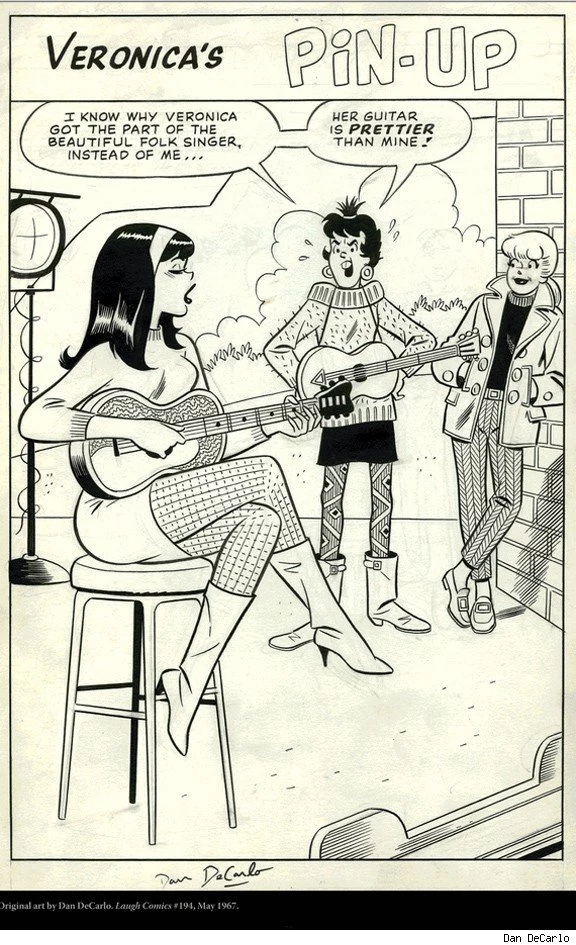
‘The Art of Betty and Veronica’ Takes a Historical View of Comics’ Frenemy Fashionistas
 It's an age old question...or, at least, a 70-year-old question: Betty or Veronica?
It's an age old question...or, at least, a 70-year-old question: Betty or Veronica?
The two female points of the love triangle at the very center of publisher Archie Comics have always formed a sort of either/or dichotomy for those male readers envious of Archie Andrews' predicament, being seemingly forced to choose between two ideal girlfriends of opposite natures. When those male readers ask themselves, or one another, "Betty or Veronica?" they're asking about what type of girl they prefer: the debutante or the girl next door? The cunning, sophisticated, fickle, wealthy heiress for whom everything comes easy, or the big-hearted, book-smart, loyal, hard-working young woman? Sugar or spice? Good girl or bad girl? Or perhaps they're just asking, more simply -- blonde or brunette?
There's a somewhat startling 1978 Betty and Veronica story by Dan DeCarlo, the cartoonist who more than any other was responsible for defining the characters' appearances and personalities, which attempted to make the point that there really is no choice at all: Betty and Veronica aren't two different girls as much as they are two halves of the same girl. The story, entitled "Split Personality," is one of the seven tales editors Victor Gorelick and Craig Yoe chose for The Art of Betty and Veronica, a new hardcover book celebrating the high school dream girls and the men whose designs and lines made them, to some, the idyllic girlfriends decade after decade.

DeCarlo's point was a rare example of a creator taking a wide, psychological view of the relationship dynamics at Riverdale High (He'd take another stab at it in 1989's "Triangle," also included in this book). Directly (if clumsily) presented as narration in a typically silly five-page story, the idea is a valid one: Betty and Veronica are different aspects of the "All-American Girl," separated in a centrifuge into characteristics best suited for a cartoon comedy of exaggerated contrasts.
In truth, Archie never really has to choose between the two -- the pair are still fighting over him, and he never has to choose for longer than the length of a gag (or the occasional alternate-future storyline). And, of course, readers never have to choose either: Betty and Veronica are always together, whether they are at peace or at war. America's original frenemies share the same title of one of the comics they appear in after all (even if they occasionally squabble over who gets top billing).

Editors Gorelick (currently the editor-in-chief of Archie Comics) and Yoe (a comics historian who produces handsomely designed themed anthologies at an enviable rate) each provide introductions to the book, as do Archie's publisher and Co-CEO Jonathan Goldwater and celebrated cartoonist and animator Bruce Timm (Batman: The Animated Series) who, perhaps realizing a picture is worth a thousand words (and one of his typically worth 30,000 words), provides a pen and ink drawing of the pair in bikinis. After introductions of each of the leading ladies, the book is then divided into decade-specific looks at their evolution, including a prose page discussing each decade and how the work of Archie Comics reflected it, followed by examples of covers and at least one full Betty and Veronica story from the era.
At 9-by-12 inches, the book is bigger than the average comic book, and colossal compared to Archie digest size. Many of the covers and stories appear in color, as they would have when originally published in the comics, but many more still are presented in black and white, allowing for a better appreciation of the line-work-in many of them, as the original pencil guidelines are clearly visible. It's a rare and welcome look at the behind the scenes process of these seemingly ubiquitous comics' creations, as well as the opportunity to appreciate the artists first and the characters second.

While there is an awful lot of great artwork between these covers, mostly of the "good girl" variety practiced for decades by artists like DeCarlo, Timm, Dave Stevens, Amanda Conner, Terry Dodson and more, where the book is of greatest value may be in its restoration of the importance of the artists in the story of Archie Comics. The publisher has a bad reputation in some circles for its treatment of some of its artists over the years, particularly when it comes to giving credit where credit is due. That is not the case here. Gorelick's introduction may be brief, but it is full of remembrances of the men he worked with. There's a page of photos of the artists whose work is seen here, and the changes of various artists over the years is given more space than the introduction of new characters to the Archie story.
DeCarlo is obviously quite well represented, as is Dan Parent, the current high profile Archie cartoonist. There's even a drawing of Archie, Betty and Veronica by Norm Breyfogle, who has been doing a lot of work with the publisher recently, and whose work there never ceases to freak me out after all the years I spent poring over his Batman comics (I see the image below and all I can think of is the teens getting off the train in 1990s Gotham City, about to get mugged unless Batman can get there in time).

Irv Novick's 1940s work is perhaps one of the bigger surprises in The Art of Betty and Veronica, given how realistic he drew the girls. Indeed, "realistic" and "Archie" aren't exactly words one is used to hearing in the same sentence.
By the 1950s, Harry Lucey and Bob Montana had given the gals their big eyes (and big breasts, it has to be said, although they would shrink in the coming decade) and cute, up-turned noses. These designs were clearly the starting point for DeCarlo's refining over the next few decades. One of his earlier covers included here looks quite close to Lucey and Montana's work, but in the later pages you can see the figures getting slimmer, the heads less rounded.

It can be somewhat shocking to see just how sexy the art is in many of these comics. The 1950s through the 1970s were quite overtly so and, if anything, Archie Comics seem to have gotten tamer and tamer in the last few decades. Bathing suits might have gotten smaller in the recent past, but there seems to have been a conscious effort to pose the girls less alluringly, whatever it is they happen to be wearing. It can be strange to look back on these old comics and see so much skin -- or such gratuitous fan service as it would be called in modern manga circles. For example, there's a pin-up drawn by Bill Vigoda for a 1947 comic, ostensibly featuring Betty demonstrating various tennis strokes.

It doubles, of course, as an excuse to ogle a pretty, scantily-clad young woman.
It's worth noting that ogling is about the extent of the sexual interaction Archie has with Betty and Veronica -- that, and some cartoon kissing of the lipstick imprint variety -- and it's generally used as one more type of joke, one that gives the cartoonists a hook on which to hang a gag while also allowing them to draw sexy young women for certain readers to stare at.
As unexpectedly sexual as so much of this art is -- there are whole DeCarlo stories set at the beach in which every panel is literally crowded with bikin-clad female figures -- the tone is remarkably innocent. As befits the purely visual medium of comics in which characters are simply two-dimensional figures drawn on paper, it's all looking and no touching for Archie, Reggie and the gang.

That dynamic is perhaps another reason why Archie can never really choose Betty or Veronica. As a comics character he can't escape the strictures of his medium, which demands a certain amount of stasis from story to story, from comic to comic and, at this point, from decade to decade. As enviable as the fork in the road of Archie's romantic life might have seemed to so many young readers over the years, we're not doomed to the same frustration he faces as a comics character. Here in the real world, we can make our own choices, we can stick to them or change or minds, we can reap the benefits (and/or suffer the consequences). We can move on.
So, Betty or Veronica? Both, obviously. DeCarlo's or Parent's? Montana's or Lucey's? Novick's or Breyfogle's? All of the above, obviously. The Art of Betty and Veronica gives them to us, and in a deluxe package full of historical context and reverence for influential talents.
The Art of Betty and Veronica is on sale now in finer comics shops and bookstores.
More From ComicsAlliance



![Take A Trip To The Relatively Murder-Free Classic Riverdale In ‘Best Of Archie 2016′ [Preview]](http://townsquare.media/site/622/files/2017/03/BestOfArchie01.jpg?w=980&q=75)
![The Blossom Twins And Pete Woods Wreak Havoc On Riverdale In ‘Archie’ #18 [Interview]](http://townsquare.media/site/622/files/2017/03/Archie00.jpg?w=980&q=75)




